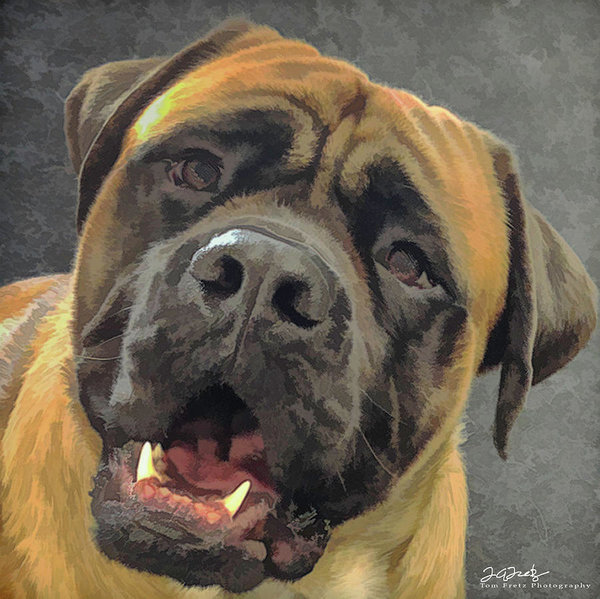
We suppose the very first person to record the Mastiff was whomever drew the outline of the huge dog on a cave wall in 3000 BC, but the breed’s first mention in literature dates to 1125 BC.
The breed continued to keep good literary company when Caesar described them during his landing in Britannia in 55 BC where he was opposed by Celtic warriors and their massive dogs. This makes the English Mastiff one of the oldest recorded breeds ever.
Along with the Greyhound, the Mastiff was one of the only dog breeds to be specifically mentioned in the Forest Laws of King Canute, written in the first decades of the 11th Century. Chaucer went on to describe the dogs “as great as any steer/To hunt at the lion or the deer” in his The Canterbury Tales written in the 14th century, though he referred to them as “Alaunts” which were probably early Mastiffs developed by the Alans and introduced by the Normans. Shakespeare also mentioned them in his piece about the British fight against the French in 1415 at the Battle of Agincourt where Mastiffs fought alongside the men.
To sidetrack for a moment, it’s possible that at that time, any large dog was referred to as a Mastiff, the name possibly coming from the French word, “Mastin,” meaning ‘watchdog.’ Other sources dispute this and claim that the name evolved from the Anglo-Saxon word “masty,” meaning “powerful.” Whatever its origin, it’s an old one. The first list of dog breed names in the English language contained within The Book of Saint Albans was published in 1486 and included “Mastiff: ”
“Thyse ben the names of houndes, fyrste there is a Grehoun, a Bastard, a Mengrell, a Mastiff, a Lemor, a Spanyel, Raches, Kenettys, Teroures,Butchers’ Houndes, Myddyng dogges, Tryndel-taylles, and Prikherid currys, and smalle ladyes’ poppees that bere awaye the flees.”
Rei Rusticae Libri Quatuor, written by Conrad Heresbach in 1570 referred to “the Mastie that keepeth the house.” That same year, a complete classification of dogs was published by Dr Johannes Caius, personal physician to Queen Elizabeth I. Written in Latin (and translated into English in 1576), the first group of dogs was divided into ‘Venatici’ and ‘ Aucupatorii,’ the Venatici being larger game hunting dogs, and the Aucupatorii used to hunt birds. It wasn’t until Caius’ fourth group that we see the Mastiff mentioned as one of two types of farm dog: Canis pastoralis, or the Shepherd’s Dogge, and “the Mastive, or Bandogge, called Canis Villaticus Or Carbenarius, which hath sundry names derived from sundry circumstances.”
The first hint of a breed standard may have been written in 1859 by Dr John Henry Walsh writing under the name, ‘Stonehenge.’ In The Dog in Health & Disease, he stated that the points of the Mastiff are: “A head of large size between that of the bloodhound and bulldog in shape having the volume of muscle of the latter, with the flews and muzzle of the former.”
The Mastiff would continue to show up not only in scholarly works, but in fiction. Jumping past centuries, we see modern authors such as Joyce Carol Oates address the breed: A piece called, “Mastiff” appeared in The New Yorker, and it is the source of our post title: “That isn’t a dog, It’s a Human Being on its Hands and Knees.” Kurt Vonnegut, Jr. in The Sirens of Titan, and Cynthia Rylant in her Henry and Mudge series written for children both included Mastiffs.
We conclude early as a mercy, and leave you with the opinion of one authority who maintains that Mastiffs appear more frequently in English records and literature than almost any other breed, probably due, in part, to their connections with royalty, and because of the antiquity of their breed.
Image: “Otis” by Tom Fretz can be purchased as wall art, home decor, and lifestyle items here
